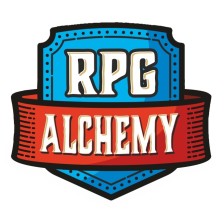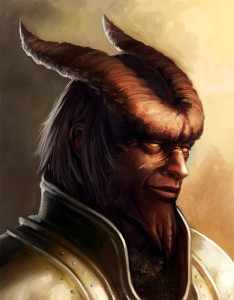Phase Four: Characters (PC’s & NPC’s)
In my last article on campaign design we talked about the importance of the party concept and discussed a variety of unique reasons for the characters to be together. Working as a group to create the party concept leads directly into character creation, something that I also recommend being done as a group.
Every RPG out there has its own system for creating characters mechanically and several systems also feature rules for creating such things as background and personality. Regardless of the game system featured in the campaign or the method we��choose to create characters, I have the players focus on two important questions during character generation:
- How did your character come to be with the group?
- Why does your character stay with the group?
The answer to the first question informs background decisions and accomplishes two important goals. It��connects each��character to the other characters in a meaningful way and it connects the character to the campaign through the party concept’s setting connection. These types of connections, along with the answer to the second question, are what keeps a campaign moving forward and helps keep the players on the same sheet of music. This makes running the campaign easier on the GM and also prevents a variety of problems that sometimes come up during a campaign.
Several years back I ran a Dungeons & Dragons campaign. At the start I pitched the idea that the campaign’s focus would be on a group of heroes working for the Assembly of Advisors in the Seven Bridges Valley. The “advisors” (i.e. adventurers) served as trouble-shooters and defenders of the valley’s five communities against threats that were more than the town guard or militia could reasonably handle. I gave each player a setting primer to look over and tasked them with coming up with how their character ended up on the Assembly and why they continued to serve. Three of the players came up with great answers (with a little group input):
 There was Dayreath, the son of a woman on the Cornerstone Council (overseers of the Assembly) that felt it was his duty to serve as well as feeling��the pressure of the expectations placed on the child of a noble.
There was Dayreath, the son of a woman on the Cornerstone Council (overseers of the Assembly) that felt it was his duty to serve as well as feeling��the pressure of the expectations placed on the child of a noble.- There was Ember, a paladin of the House of Light that was “called by Bahamut” to serve and defend the valley. She knew that through selfless sacrifice and dedication Bahamut’s will would be done to the benefit of the people.
- There was Arnz, a rogue that was nominated to the Assembly after a case of mistaken identity. He (the character) didn’t want to be an Advisor but discovered it was a great way to continue his larcenous career because “guards don’t hassle Advisors”.
Then there were two other players in the group that didn’t feel the need to work within the campaign’s assumptions:
- There was (can’t remember the name) the wizard whose player couldn’t be bothered to read the primer. He was “from another country” and was “here to adventure.”
- There was also a forgettable ranger that couldn’t make any decisions, rejected several ideas the group came up with and decided he was “a loner with a mysterious past.”
Over the first few��sessions of the campaign both players became increasingly frustrated with the game. I tried to find ways to connect their characters more solidly to the campaign but regardless of what lifelines I offered they refused to grab hold. I was becoming more frustrated as a GM and finally after the wizard’s player said “Why do I even care about what happens to the village?”, I lost it. I stopped the game and said, “No shit! Why would you give a damn! You’re not from the valley, you don’t know anyone here, you have no desire to serve or help, you aren’t friends or allies with the other adventurers, in fact all you are is some 3rd level human wizard. Do any of us even know your character’s name? More importantly do any of us give a fuck!?”
Not my finest moment as a GM. But in retrospect it demonstrated the importance of characters having a real connection to the campaign. By the by, that was the last time I gamed with the wizard’s player and the ranger’s player, seeing the writing on the wall began putting some effort into his character. Actually the ranger died (no one mourned), but his replacement character was more connected and he enjoyed the campaign to a greater degree.
To further illustrate the importance of connection��we had another player join us after the wizard left. He read the primer and said he wanted to play a fighter. Since the Assembly is a fairly small group, and his character had never been mentioned he asked if he could serve the Council directly. We decided that he was a sergeant in the Cornerstone guard (setting connection) and served Dayreath’s mother on the council (party connection). Verick’s brother was an NPC on the Assembly (setting connection) and his wife and kids lived in Cornerstone (setting connection). He was pledged by the council woman to assist her son (party connection). Although he joined the campaign late, Verick became one of the most important figures in the campaign. The entire party celebrated his promotion to captain. Everyone was emotionally invested in the rescue of his kidnapped children. The group befriended his wife and she became an important ally to the party. All of these memorable moments were spun out of the character’s connection to the party and the setting.
As you probably guessed this is why it’s so important to have a solid party concept prior to rolling-up characters. Understanding why the characters stay together is also a great opportunity to think about what could tear them apart or cause them to go their separate ways. This isn’t something I discuss with the players but having a few ideas about what would cause the party concept to dissolve can give you as GM some insight into how the campaign should wrap-up. A good solid ending to a campaign is important.
Supporting Cast
While we’re creating characters and forging connections I use the time to also start forming��my list of NPC’s. I start with friends, relatives, allies, rivals and enemies of the characters. Almost every connection a player creates is going to have at least one or two people associated with it. I don’t usually detail these NPC’s, just a name and a quick description focused on their own connection to the PC’s or to the setting. In the campaign I was mentioning 15 to 20 NPC’s emerged during initial character creation, including:
- Lady Eveningstar, an elven noble who leads with grace and dignity. (Dayreath’s mother)
- Father Voldara, a human priest who worships Erathis. (Ember’s mentor)
- Daria Fendoran, a human barkeeper who owns the Last Star Inn. (Arnz’s sister)
By the way when I creat an NPC I use the same format that is used in Numenera for a character. For those of you that are unfamiliar with Numenera the format looks something like this: [name] a [primary descriptors] who [primary focus/trait], as in Lord Baraxis [name] a tiefling nobleman [primary descriptors] who rules Cinderhill from the shadows [primary focus]. I’ve found this to be a great format for consistency and the amount of information conveyed in a brief sentence.
Final Thoughts
The party concept and the characters form the heart and soul of any campaign. Adventures and stories are important but it is the relationship between those adventures��and the heroes that form the basis of an epic campaign story. Now that we have our campaign’s elements, its look and feel, a party concept and the primary character’s we’re ready to set all of this in motion and breathe life into the campaign. See you next time.
Links to the RPG Alchemy’s entire Campaign Design series:
- Prelude
- Phase 1: Initial Campaign Elements
- Phase 2: Campaign Look & Feel
- Phase 3: The Party Concept
- Phase 4: Characters (PC’s & NPC’s)
- Phase 5: Setting Things in Motion
- Final Thoughts

